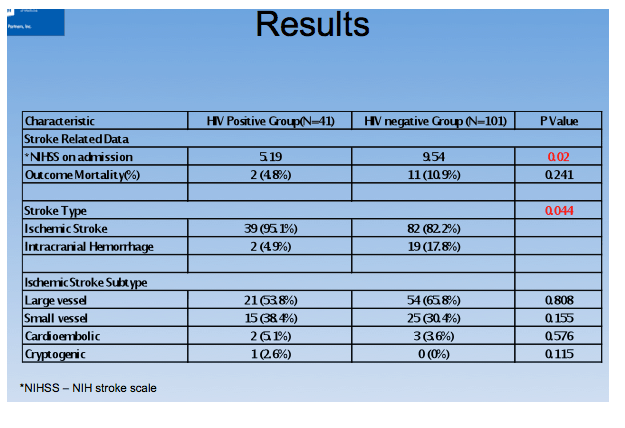 |
 |
 |
| |
Stroke in human immunodeficiency virus (HIV) infected patients
|
| |
| |
Reported by Jules Levin
19th Intl AIDS Conf Wash DC July 22-27 2012
Presented by Masayuki Nigo (United States).
"The fact that HIV+ patients compared to HIV- patients were significantly younger (57 vs 72 yrs of age) and yet had greater likelihood of ischemic stroke despite similar traditional risk factors, supports that HIV in some way promotes stroke"

M. Nigo1, A. Walker2, D. Lucido3, A. Shah2, M. Skliut2, D. Mildvan4
1Beth Israel Medical Center, and Albert Einstein College of Medicine, Internal Medicine, New York, United States, 2Beth Israel Medical Center, and Albert Einstein College of Medicine, Neurology, New York, United States, 3Beth Israel Medical Center, and Albert Einstein College of Medicine, New York, United States, 4Beth Israel Medical Center, and Albert Einstein College of Medicine, Infectious Diseases, New York, United States
From authors:
Among stroke patients, the proportion found to be HIV+ is increasing over time:
- 0.09% in 1997 vs. 0.15% in 2006 (2)
The incidence of ischemic stroke is higher in HIV+ patients:
- 5.27/1000 person-years in HIV + patients
- 3.75/1000 person-years in HIV - patients (3)
Many hypotheses have been proposed to explain the increased incidence of stroke in HIV patients:
·Accelerated Atherosclerosis
- HIV/HAART related dyslipidemia, metabolic syndrome (1)
- Endothelial dysfunction due to HIV protein, HIV vasculopathy(2)
- Lifestyle factors, e.g. smoking (3)
·Hypercoagulability
- Immune activation due to infections
- Protein S deficiency (4)
- Anti-phospholipid antibodies(5)
·Opportunistic Infection
- Increased systemic inflammation
- CNS infections, e.g. meningitis due to tuberculosis or cryptococcus
- Vasculitis due to syphilis, viruses (VZV, HSV) (6)
·The goal of our study:
To compare clinical and epidemiological characteristics of stroke patients with and without HIV infection
Background: Current literature indicates that infection with HIV contributes to an increased risk of acute stroke. The goal of this study is to compare clinical and epidemiological characteristics of stroke patients with and without HIV infection.
Methods: We performed a retrospective chart review of stroke patients who were admitted to the stroke unit between January of 2005 and June of 2011. We identified 43 patients with known HIV infection at the time of admission for acute stroke. 101 controls were randomly selected from non-HIV patients who had acute stroke within the same time period. Clinical and epidemiological characteristics of two groups were compared.
Results: Of 1679 admissions with acute stroke, 43 (2.6%) were in HIV-infected patients (32 males, 11 females) and 101 in non-HIV infected patients (45 males, 56 females). Mean age was 57.8 years and 72.6 years, respectively. All 144 patients had acute ischemic stroke confirmed by imaging. Significant difference was identified in age, race, blood pressure on admission, National Institute of Health Stroke Scale (NIHSS) on admission, and HDL level (Table 1). The presence of co-morbidities (HTN, DM, hyperlipidemia), body mass index (BMI), homocysteine level, LDL, and coagulation profiles were not statistically different between two groups. In the HIV+ group, 30 patients (83%) were taking HAART prior to stroke onset. CD4 count was available in 37 patients; 21 had CD4 >200 cells/mm3 and 16 had CD4< 200 cells/mm3 (mean CD4 count = 329.7 cells/mm3).

Conclusions: HIV infection increases the risk of stroke in younger patients. They have lower blood pressure, HDL and NIH stroke scale on admission compared to HIV negative stroke patients. Prevalence of DM, HTN, hyperlipidemia and other metabolic factors were not significantly different in the two groups, although the relatively small sample size and retrospective nature of the study represent limiting factors.





|
| |
|
 |
 |
|
|